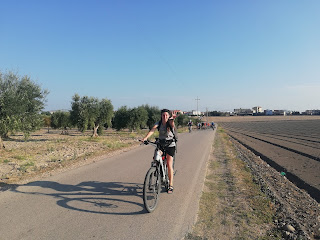32. 5 km
E io andrò molto lontano, oltre quei monti, oltre i mari, vicino alle stelle
- written on a panel in the museum in Ascoli Satriano
This morning I left behind the foothills of the Daunia and entered the flatlands of the Tavoliere delle Puglie. Once the bottom of the sea, this is Italy's second largest plain, after the Pianura Padana. Walking across it is an experience comparable to that of crossing the Mesetas in Spain. I began to see why the Road to Rome group decided to cover this ground by bicycle!
I woke up later than usual, so instead of getting off to an early start I went to the town square in Ordona to see the group of cyclists assemble. I set off just before them, and they soon passed me on the road out of town.
I spent the day walking on perfectly flat, straight roads, gravel and paved, through fertile agricultural land. Not only wheat, olives and grapes are grown here, but also artichoke, tomatoes, and some sort of bluish cabbage... Not sure whether it might be a root crop, as the leaves don't appear very edible, but it gives off a very cabbagy smell!
I arrived in the village of Stornarella not long after the cyclists had departed, having taken a break to meet with the local authorities. Some of the organisers of the event recognised me as part of the Road to Rome group (I was wearing the T-shirt) and brought me water and a snack. From here it was only a few kilometres to Stornara, along the zigzag route taken by the Via Francigena; I managed to shorten this even further by taking the zig but not the zag, for at the point where the Francigena crossed the highway, there was a separate cycling lane leading all the way into the town of Stornara.
 |
| Ploughing along the cycling lane towards Stornara |
The cycling lane seemed to be used not so much by recreational cyclists as by Africans on their way from the town out into the fields to work. The multi-ethnic population of Stornara consists largely of migrant farm workers. The town itself has been rescued from anonymity by a series of gigantic mural paintings adding character and colour.
 |
| San Rocco, patron saint of pilgrims, with blue ladyfriend |
Coming out of Stornara, I passed through cool, shady olive groves along a gravel path. The olives here are gigantic - the size of small apricots - a unique variety famous all over the world known as Bella di Cerignola.
As I approached the town of Cerignola I was in touch with Maria of the local Via Francigena association, whom everyone had recommended I talk to about accommodations. She came to pick me up on the outskirts of the town and took me to meet the other members of the association at their headquarters at Terra Aut, an eight hectare piece of land and house confiscated from criminals and converted into a community centre and farm which employs former convicts and drug addicts attempting to make a new life for themselves. Through civic education and social agriculture, the centre attempts to combat the criminal activity for which the town if Cerignola is renowned. Not street crime that would represent a threat to the passing pilgrim, but more organised forms of criminal activity going on behind the scenes, such as car theft on commission merely to obtain parts - so my hosts for the evening explained to me over dinner at their home.
The family hosting me actually lives out in the country five kilometres beyond Cerignola, which means I did not get a chance to see the city centre, but it also means I will get a head start on tomorrow 's stage!














No comments:
Post a Comment